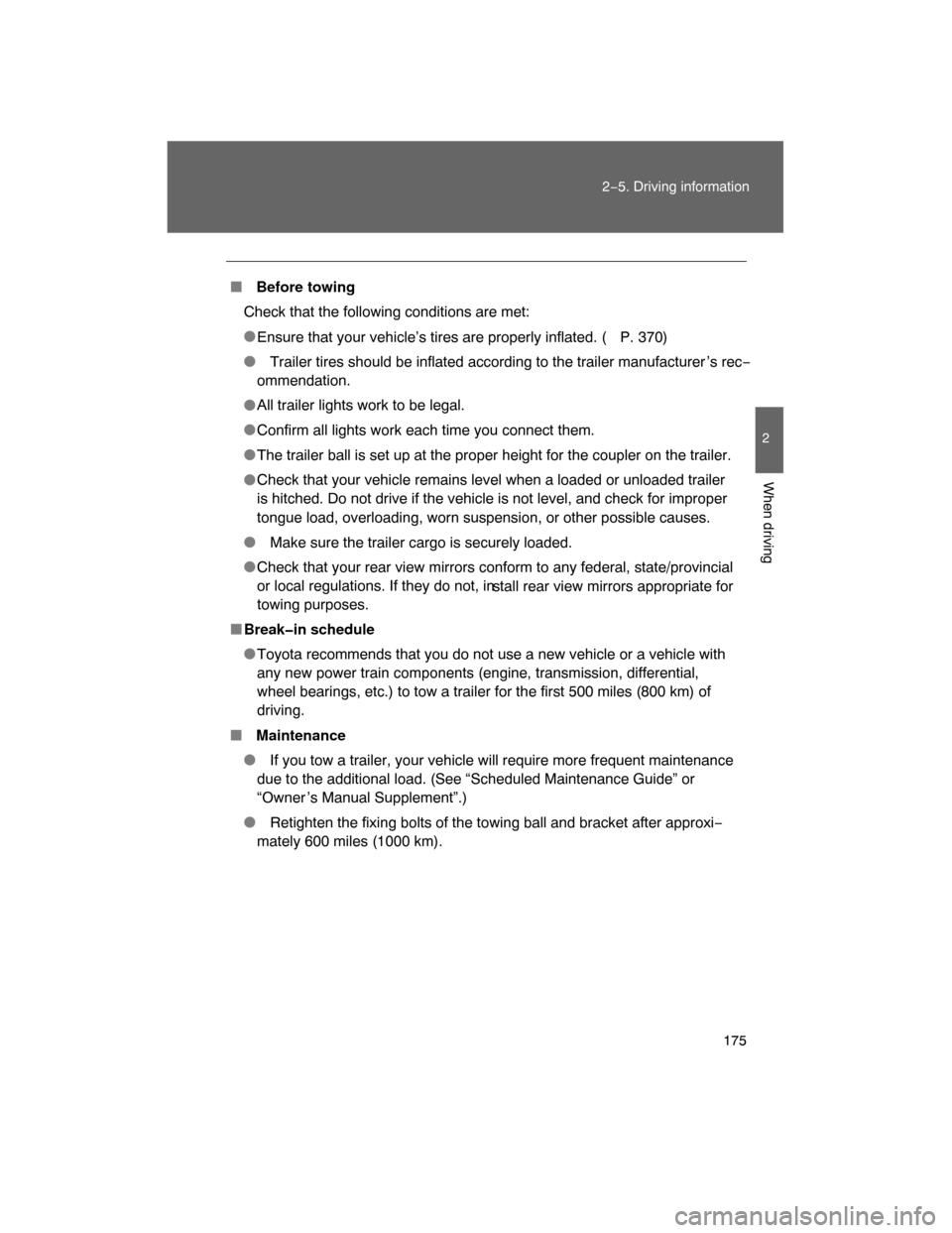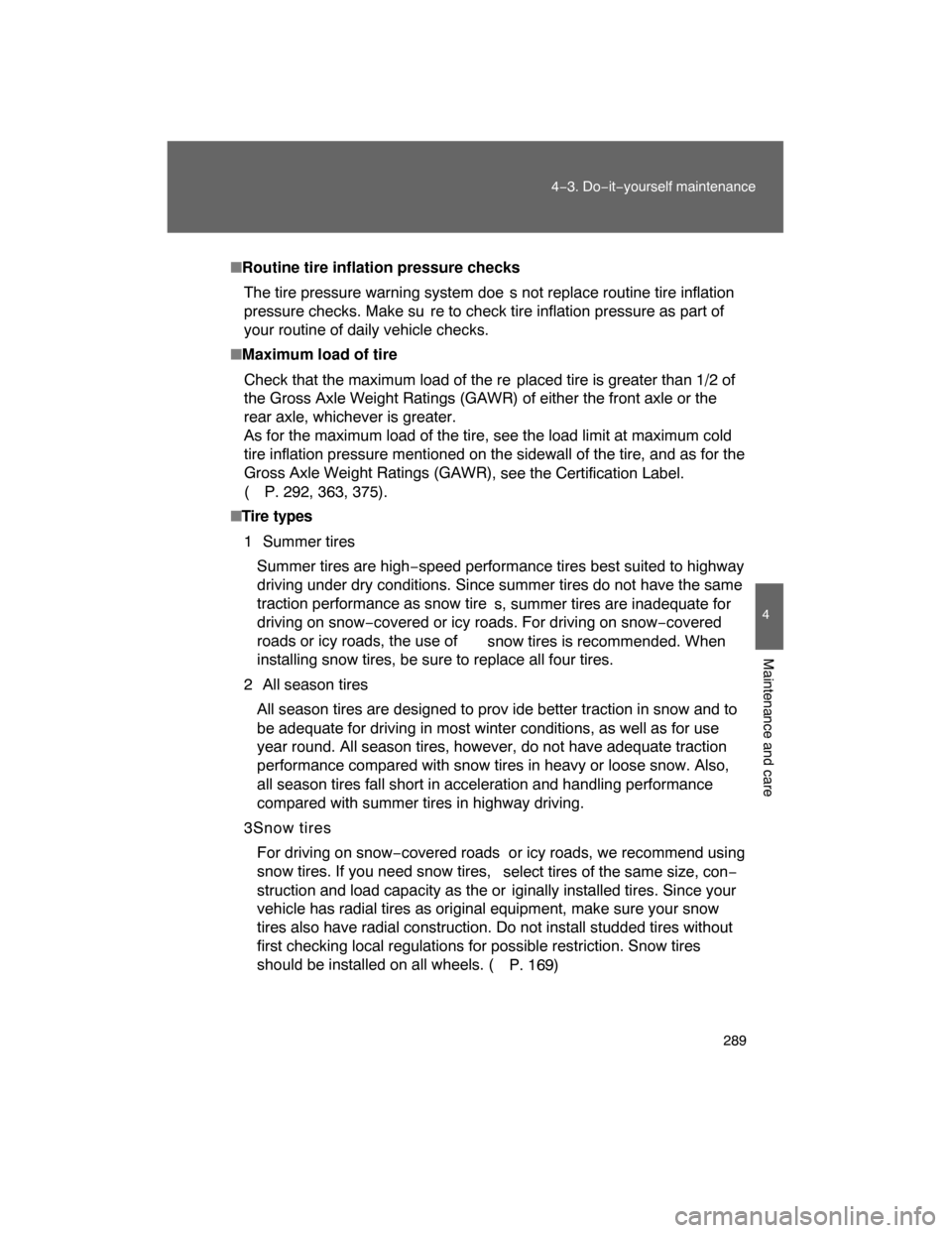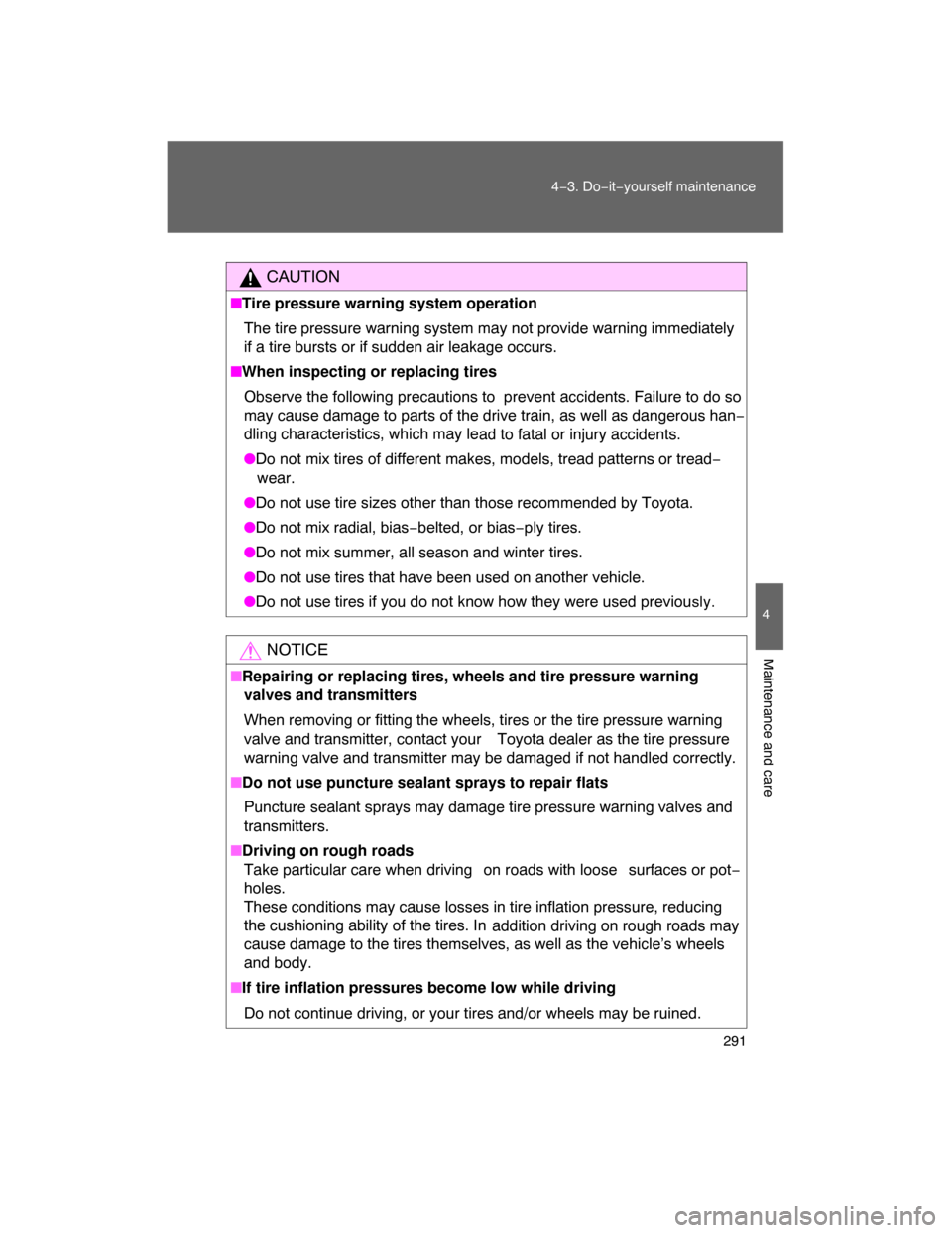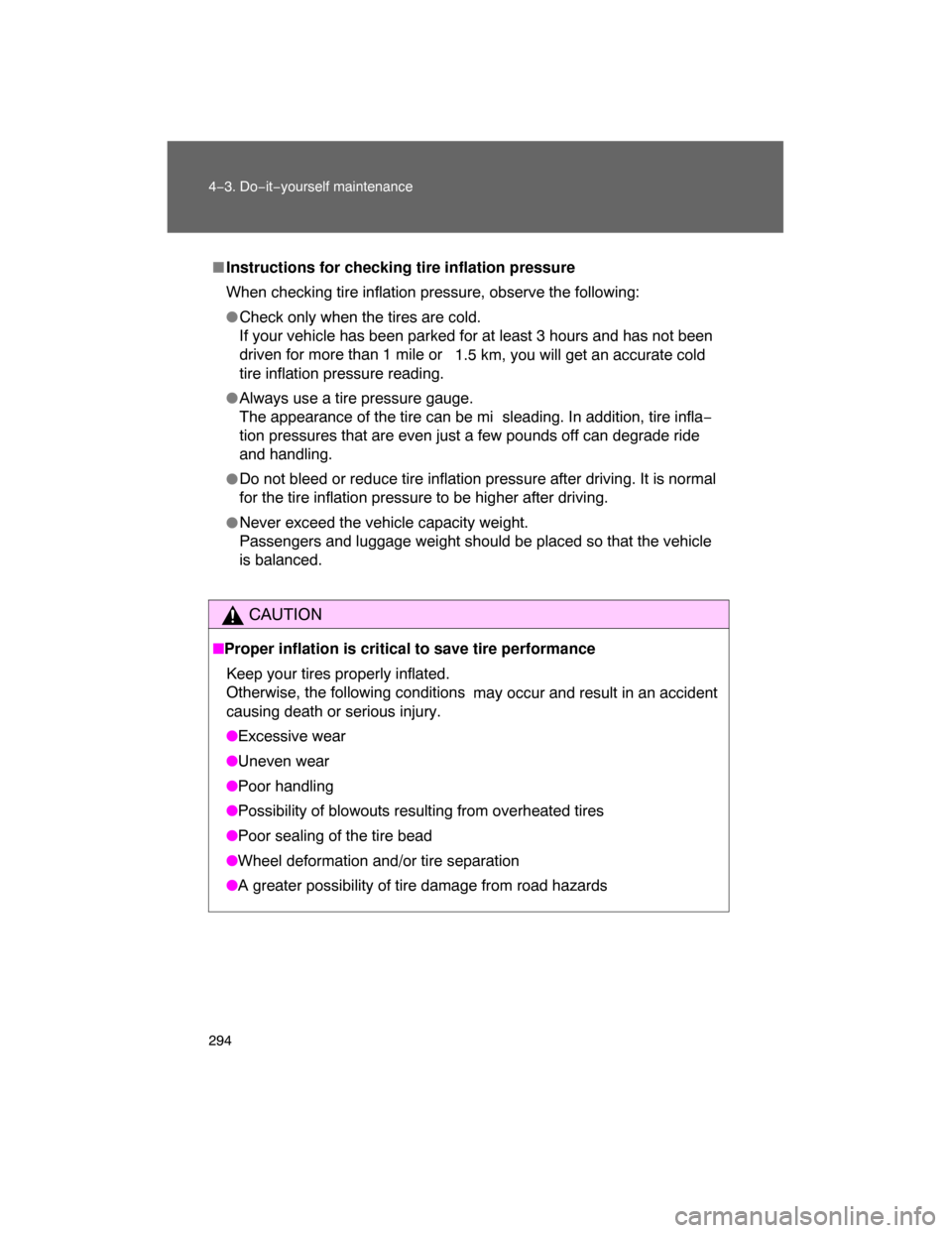Page 173 of 400

175
2−5. Driving information
2
When driving
� Before towing
Check that the following conditions are met:
�
Ensure that your vehicle’s tires are properly inflated. ( P. 370)
� Trailer tires should be inflated according to the trailer manufacturer ’s rec−
ommendation.
�All trailer lights work to be legal.
�Confirm all lights work each time you connect them.
�The trailer ball is set up at the proper height for the coupler on the trailer.
�Check that your vehicle remains level when a loaded or unloaded trailer
is hitched. Do not drive if the vehicle is not level, and check for improper
tongue load, overloading, worn suspension, or other possible causes.
� Make sure the trailer cargo is securely loaded.
�Check that your rear view mirrors conform to any federal, state/provincial
or local regulations. If they do not, in
stall rear view mirrors appropriate for
towing purposes.
�Break�in schedule
�Toyota recommends that you do not use a new vehicle or a vehicle with
any new power train components (engine, transmission, differential,
wheel bearings, etc.) to tow a trailer for the first 500 miles (800 km) of
driving.
� Maintenance
� If you tow a trailer, your vehicle will require more frequent maintenance
due to the additional load. (See “Scheduled Maintenance Guide” or
“Owner ’s Manual Supplement”.)
� Retighten the fixing bolts of the towing ball and bracket after approxi−
mately 600 miles (1000 km).
Page 263 of 400
267
4−2. Maintenance
4
Maintenance and care
Vehicle exterior
Steering wheel
�Moves smoothly?
�Has correct free play?
�No strange noises?
Items Check points
Door�Operate smoothly?
Engine hood�The lock system works properly?
Fluid leaks�Is there any leakage after park−
ing?
Ti re�Inflation pressure is correct?
�Tire surfaces not worn or dam−
aged?
�Tires rotated according to the
maintenance schedule?
�Wheel nuts are not loose?
CAUTION
� If the engine is running
Turn the engine off and ensure that there is adequate ventilation before per−
forming maintenance checks.
ItemsCheck points
Page 283 of 400
287
4−3. Do−it−yourself maintenance
4
Maintenance and care
Tires
Replace or rotate tires in accordance with maintenance sched�
ules and treadwear.
� Checking tires
New tread
Treadwear indicator
Worn tread
The location of treadwear
indicators is shown by the
“TWI” or “ ” marks, etc.,
molded on the sidewall of
each tire.
Check spare tire condition
and inflation pressure if not
rotated.
� Tire rotation
Rotate the tires in the order
shown.
To equalize tire wear and
extend tire life, Toyota recom−
mends that tire rotation is
carried out at the same inter−
val as tire inspection.
� The tire pressure warning system
Your Toyota is equipped with a tire pressure warning system that
uses tire pressure warning valves
and transmitters to detect low
tire inflation pressure before serious problems arise. (
P. 334)
213
Front
Page 284 of 400

288 4−3. Do−it−yourself maintenance
Installing tire pressure warning valves and transmitters
When replacing tires or wheels, tire pressure warning valves and
transmitters must also be installed.
When new tire pressure warning valves and transmitters are installed,
sensor ID codes must be registered in the tire pressure warning com−
puter.
Registering ID codes
The tire pressure warning valve and transmitter is equipped with a
unique ID code. When replacing a tire pressure warning valve and
transmitter, it is necessary to regi ster the ID code of tire pressure
warning valve and transmitter. Have the ID code registered by your
Toyota dealer.
If the ID code is not registered , the system will not work properly.
After about 20 minutes, the tire pressure warning light comes on after
blinking for 1 minute to indicate a system malfunction.
�When to replace your vehicle’s tires
Tires should be replaced if:
�You have tire damage such as cuts, splits, cracks deep enough to
expose the fabric or bulges indicating internal damage
�A tire goes flat repeatedly or c
annot be properly repaired due to the
size or location of a cut or other damage
If you are not sure, consult with your Toyota dealer.
�Tire life
Any tire over 6 years old must be checked by a qualified technician even
if they have seldom or never been used or damage is not obvious.
�If the tread wears down below 0.16 in. (4 mm) on snow tires
The effectiveness of snow tires is lost.
Page 285 of 400

289
4−3. Do−it−yourself maintenance
4
Maintenance and care
�Routine tire inflation pressure checks
The tire pressure warning system doe s not replace routine tire inflation
pressure checks. Make su re to check tire inflation pressure as part of
your routine of daily vehicle checks.
�Maximum load of tire
Check that the maximum load of the re placed tire is greater than 1/2 of
the Gross Axle Weight Ratings (GAWR) of either the front axle or the
rear axle, whichever is greater.
As for the maximum load of the tire, see the load limit at maximum cold
tire inflation pressure mentioned on the sidewall of the tire, and as for the
Gross Axle Weight Ratings (GAWR)
, see the Certification Label.
( P. 292, 363, 375).
�Tire types
1 Summer tires
Summer tires are high−speed performance tires best suited to highway
driving under dry conditions. Since summer tires do not have the same
traction performance as snow tire
s, summer tires are inadequate for
driving on snow−covered or icy roads. For driving on snow−covered
roads or icy roads, the use of
snow tires is recommended. When
installing snow tires, be sure to replace all four tires.
2 All season tires
All season tires are designed to prov ide better traction in snow and to
be adequate for driving in most winter conditions, as well as for use
year round. All season tires, however, do not have adequate traction
performance compared with snow tires in heavy or loose snow. Also,
all season tires fall short in acceleration and handling performance
compared with summer tires in highway driving.
3Snow tires
For driving on snow−covered roads or icy roads, we recommend using
snow tires. If you need snow tires,
select tires of the same size, con−
struction and load capacity as the or iginally installed tires. Since your
vehicle has radial tires as original equipment, make sure your snow
tires also have radial construction. Do not install studded tires without
first checking local regulations for possible restriction. Snow tires
should be installed on all wheels. (
P. 169)
Page 287 of 400

291
4−3. Do−it−yourself maintenance
4
Maintenance and care
CAUTION
�Tire pressure warning system operation
The tire pressure warning system may not provide warning immediately
if a tire bursts or if
sudden air leakage occurs.
�When inspecting or replacing tires
Observe the following precautions to prevent accidents. Failure to do so
may cause damage to parts of the drive train, as well as dangerous han−
dling characteristics, which may le
ad to fatal or injury accidents.
�Do not mix tires of different makes, models, tread patterns or tread−
wear.
�Do not use tire sizes other than those recommended by Toyota.
�Do not mix radial, bias−belted, or bias−ply tires.
�Do not mix summer, all season and winter tires.
�Do not use tires that have been used on another vehicle.
�Do not use tires if you do not know how they were used previously.
NOTICE
�Repairing or replacing tires, wheels and tire pressure warning
valves and transmitters
When removing or fitting the wheels, tires or the tire pressure warning
valve and transmitter, contact your Toyota dealer as the tire pressure
warning valve and transmitter may be damaged if not handled correctly.
�Do not use puncture sealant sprays to repair flats
Puncture sealant sprays may damage tire pressure warning valves and
transmitters.
�Driving on rough roads
Take particular care when driving on roads with loose surfaces or pot−
holes.
These conditions may cause losses in tire inflation pressure, reducing
the cushioning ability of the tires. In
addition driving on rough roads may
cause damage to the tires themselves, as well as the vehicle’s wheels
and body.
�If tire inflation pressures become low while driving
Do not continue driving, or your tires and/or wheels may be ruined.
Page 290 of 400

294 4−3. Do−it−yourself maintenance
�Instructions for checking tire inflation pressure
When checking tire inflation pressure, observe the following:
�Check only when the tires are cold.
If your vehicle has been parked for at least 3 hours and has not been
driven for more than 1 mile or
1.5 km, you will get an accurate cold
tire inflation pressure reading.
�Always use a tire pressure gauge.
The appearance of the tire can be mi
sleading. In addition, tire infla−
tion pressures that are even just a few pounds off can degrade ride
and handling.
�Do not bleed or reduce tire inflation pressure after driving. It is normal
for the tire inflation pressure to be higher after driving.
�Never exceed the vehicle capacity weight.
Passengers and luggage weight should be placed so that the vehicle
is balanced.
CAUTION
�Proper inflation is critical to save tire performance
Keep your tires properly inflated.
Otherwise, the following conditions
may occur and result in an accident
causing death or serious injury.
�Excessive wear
�Uneven wear
�Poor handling
�Possibility of blowouts resulting from overheated tires
�Poor sealing of the tire bead
�Wheel deformation and/or tire separation
�A greater possibility of tire damage from road hazards
Page 292 of 400

296
4−3. Do−it−yourself maintenance
Wheels
�When replacing wheels
The wheels of your Toyota are equipped with sensors that allow the tire
pressure warning system sensors to provide advanced warning in the
event of a loss in tire inflation pressure. Whenever wheels are replaced,
the tire pressure warning valve and transmitter must be switched over
from the old wheels. (
P. 288) If a wheel is bent, cracked or heavily corroded, it should be
replaced.
Otherwise, the tire may separate from the wheel or cause loss of
handling control.
� Wheel selection
When replacing wheels, care should be taken to ensure that
they are equivalent to those removed in load capacity, diameter,
rim width, and offset.
Replacement wheels are available at your Toyota dealer.
Toyota does not recommend using:
�
Wheels of different sizes or types
�Used wheels
�
Bent wheels that have been straightened
�
Aluminum wheel precautions (if equipped)
�Use only Toyota wheel nuts and wrench designed for use with
your aluminum wheels.
� When rotating, repairing or changing your tires, check that the
wheel nuts are still tight after driving 1000 miles (1600 km).
�
Be careful not to damage the aluminum wheels when using
tire chains.
� Use only Toyota genuine balance weights or equivalent and a
plastic or rubber hammer when balancing your wheels.